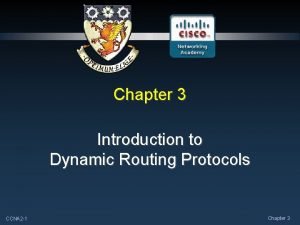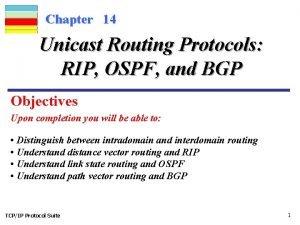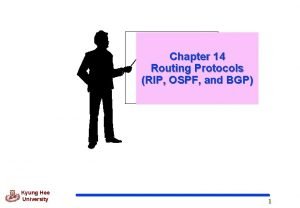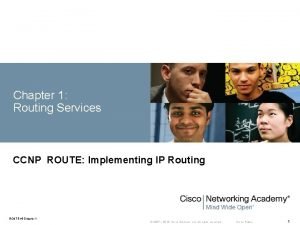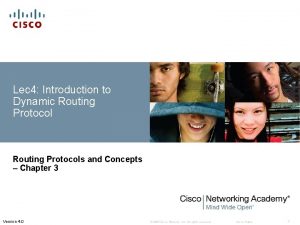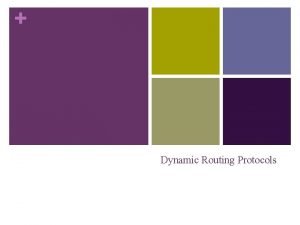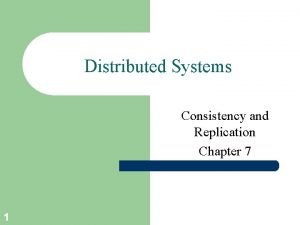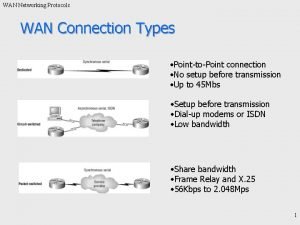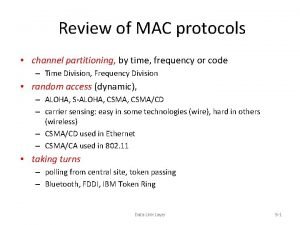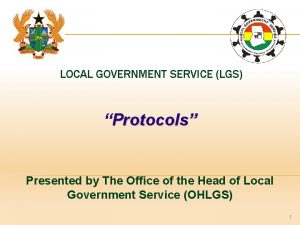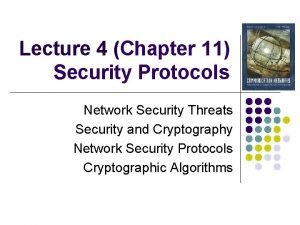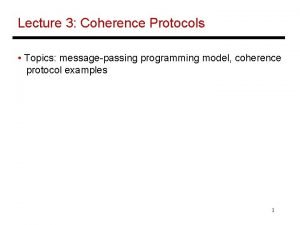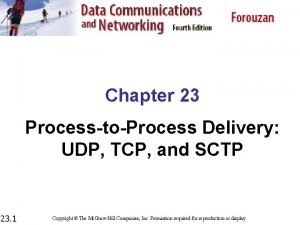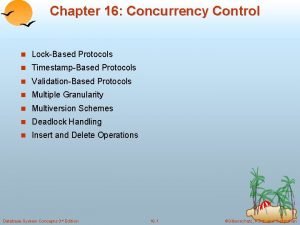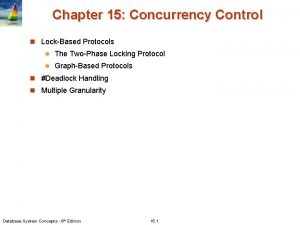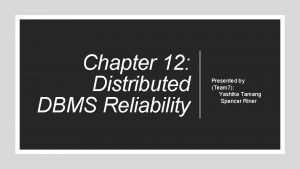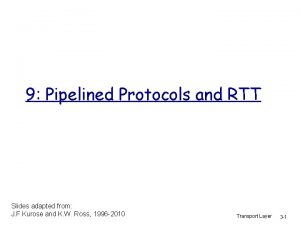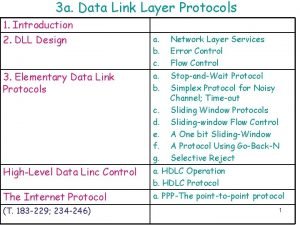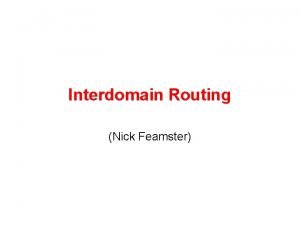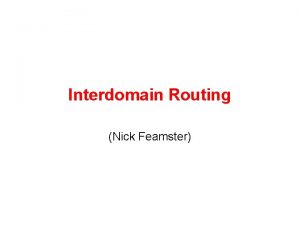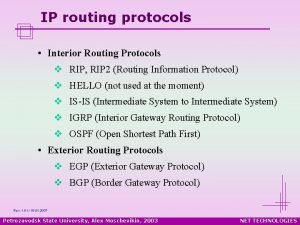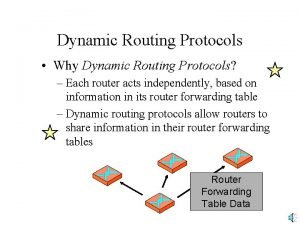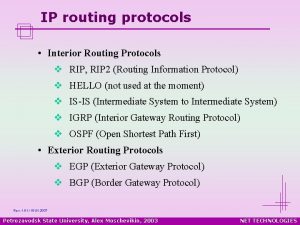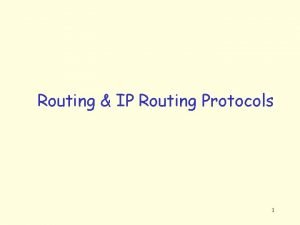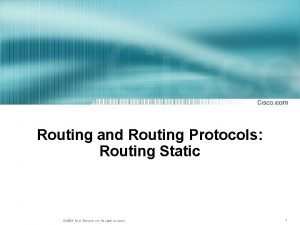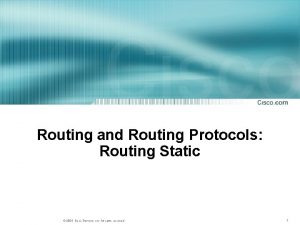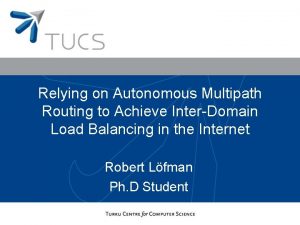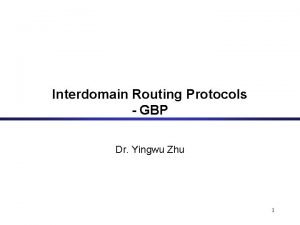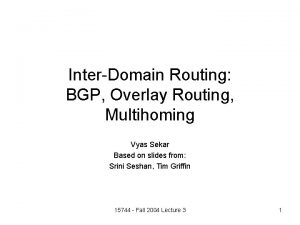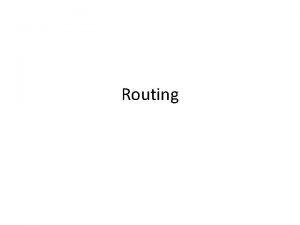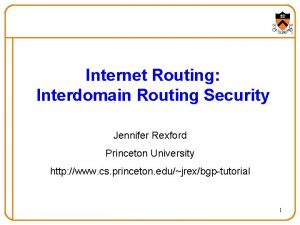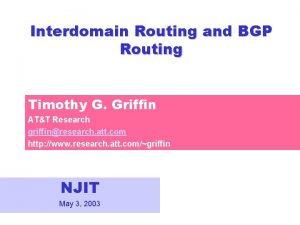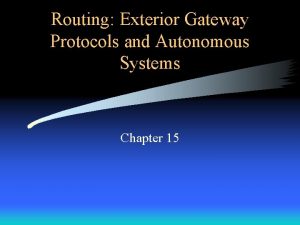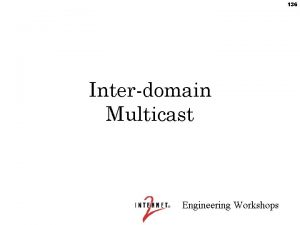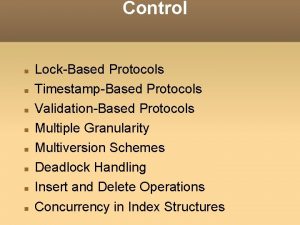Interdomain Routing Protocols 1 Autonomous Systems An autonomous




































- Slides: 36

Interdomain Routing Protocols 1

Autonomous Systems • An autonomous system (AS) is a region of the Internet that is administered by a single entity and that has a unified routing policy • Each autonomous system is assigned an Autonomous System Number (ASN). • Uof. T’s campus network (AS 239) • Rogers Cable Inc. (AS 812) • Sprint (AS 1239, AS 1240, AS 6211, …) • Interdomain routing is concerned with determining paths between autonomous systems (interdomain routing) • Routing protocols for interdomain routing are called exterior gateway protocols (EGP) 2

Interdomain and Intradomain Routing • Routing protocols for intradomain routing are called interior gateway protocols (IGP) – Objective: shortest path • Routing protocols for interdomain routing are called exterior gateway protocols (EGP) – Objective: satisfy policy of the AS 3

Interdomain vs Intradomain • Intradomain routing – Routing is done based on metrics – Routing domain is one autonomous system • Interdomain routing – Routing is done based on policies – Routing domain is the entire Internet 4

Interdomain Routing • Interdomain routing is based on connectivity between autonomous systems • Interdomain routing can ignore many details of router interconnection 5

AS Graphs AT&T North America From: T. Griffin, BGP Tutorial, ICNP 2002 6

Multiple Routing Protocols • Multiple routing protocols can run on the same router • Each routing protocol updates the routing table 7

Autonomous Systems Terminology • local traffic = traffic with source or destination in AS • transit traffic = traffic that passes through the AS • Stub AS = has connection to only one AS, only carry local traffic • Multihomed AS = has connection to >1 AS, but does not carry transit traffic • Transit AS = has connection to >1 AS and carries transit traffic 8

Stub and Transit Networks • AS 1, AS 2, and AS 5 are stub networks • AS 2 is a multi-homed stub network • AS 3 and AS 4 are transit networks 9

Selective Transit Example: • Transit AS 3 carries traffic between AS 1 and AS 4 and between AS 2 and AS 4 • But AS 3 does not carry traffic between AS 1 and AS 2 • The example shows a routing policy. 10

Customer/Provider • A stub network typically obtains access to the Internet through a transit network. • Transit network that is a provider may be a customer for another network • Customer pays provider for service 11

Customer/Provider and Peers • • Transit networks can have a peer relationship Peers provide transit between their respective customers Peers do not provide transit between peers Peers normally do not pay each other for service 12

Shortcuts through peering • Note that peering reduces upstream traffic • Delays can be reduced through peering • But: Peering may not generate revenue 13

Border Gateway Protocol (BGP) • Border Gateway Protocol is the interdomain routing protocol for the Internet for routing between autonomous systems • Currently in version 4 (1995) – Network administrators can specify routing policies – BGP is a distance vector protocol (However, routing messages in BGP contain complete routes) • Uses TCP to transmit routing messages 14

Border Gateway Protocol (BGP) • An autonomous system uses BGP to advertise its network address(es) to other AS’s • BGP helps an autonomous system with the following: 1. Collect information about reachable networks from neighboring AS’s 2. Disseminate the information about reachable networks to routers inside the AS and to neighboring AS’s 3. Picks routes if there are multiple routes available 15

BGP interactions • Router establishes a TCP connection (TCP port 175) • Routers exchange BGP routes • Periodically send updates • BGP is executed between two routers – BGP session – BGP peers or BGP speakers • Note: Not all autonomous systems need to run BGP. On many stub networks, the route to the provider can be statically configured 16

BGP interactions • The networks that are advertised are network IP addresses with a prefix, E. g. , 128. 100. 0. 0/16 Prefixes reachable from AS 1 Prefixes reachable from AS 3 17

BGP interactions • BGP peers advertise reachability of IP networks • A advertises a path to a network (e. g. , 10. 0/8) to B only if it is willing to forward traffic going to that network • Path-Vector: – A advertises the complete path to the advertised network – Path is sent as a list of AS’s this avoids loops 18

BGP Sessions • External BGP session (e. BGP): Peers are in different AS’es • Internal BGP session (i. BGP) Peers are in different AS’es • Note that i. BGP sessions are going over routes that are set up by an intradomain routing protocol! 19

i. BGP sessions • All i. BGP peers in the same autonomous system are fully meshed • Peer announces routes received via e. BGP to i. BGP peers • But: i. BGP peers do not announce routes received via i. BGP to other i. BGP peers 20

Hot Potato Routing • Router R 3 in autonomous system A receives two advertisements to network X – Which route should it pick? • Hot Potato Rule: Select the i. BGP peer that has the shortest IGP route • Analogy: Get the packet out of one’s own AS as quickly as possible, i. e. , on the shortest path 21

Hot Potato Routing Finding the cheapest IGP route: • Compare the cost of the two paths – R 3 R 1 – R 3 R 2 according to the IGP protocol • Here: R 1 has the shortest path • Add a routing table entry for destination X 22

Hot Potato Routing can backfire! • AS 1 would serve its customer (source) better by not picking the shortest route to AS 2 • In fact, customer may have paid for a high-bandwidth service! 23

BGP Message Types • Open: Establishes a peering session • Keep Alive: Handshake at regular intervals to maintain peering session • Notification: Closes a peering session • Update: Advertises new routes or withdraws previously announced routes. Eachannounced route is specified as a network prefix with attribute values 24

Content of Advertisements • BGP routers advertise routes • Each route consists of a network prefix and a list of attributes that specify information about a route • Mandatory attributes: ORIGIN AS_PATH NEXT_HOP • Many other attributes 25

ORIGIN attribute • Originating domain sends a route with ORIGIN attribute • ORIGIN attributes also specifies if the origin is internal to the AS or not 10. 0. 1. 0/8, ORIGIN {1} 26

AS-PATH attributes • Each AS that propagates a route prepends its own AS number – AS-PATH collects a path to reach the network prefix • Path information prevents routing loops from occurring • Path information also provides information on the length of a path (By default, a shorter route is preferred) • Note: BGP aggregates routes according to CIDR rules 10. 0. 1. 0/8, AS-PATH {1} 10. 0. 1. 0/8, AS-PATH {4, 2, 1} 10. 0. 1. 0/8, AS-PATH {3, 1} 27

NEXT-HOP attributes • Each router that sends a route advertisement it includes its own IP address in a NEXT-HOP attribute • The attribute provides information for the routing table of the receiving router. 10. 0. 1. 0/8, NEXT-HOP {128. 100. 11. 1} 10. 0. 1. 0/8, NEXT-HOP {128. 143. 71. 21} 28

Connecting NEXT-HOP with IGP information 10. 1. 1. 0/8, NEXT-HOP {128. 100. 11. 1} At R 1: Routing table Dest. Next hop 128. 100. 11. 0/24 192. 0. 1. 2 BGP info Dest. Next hop 10. 1. 1. 0/8 128. 100. 11. 1 Routing table Dest. Next hop 128. 100. 11. 0/24 192. 0. 1. 2 10. 1. 1. 0/8 192. 0. 1. 2 29

Route Selection • Router may get more than one route to an address • Rules for selecting a route (in order of priorities): – Preferences can be advertised as an attribut – Shorter routes are preferred – Close next-hop is preferred • Router may not want to advertise some routes 30

Importing and Exporting Routes • An AS may not accept all routes that are advertised • An AS may not advertise certain routes • Route policies determines which routes are filtered • If an AS wants to have less inbound traffic it should adapt its export rules • If an AS wants to control its inbound traffic, it adapts import rules 31

Routing Policies • Since AS 5 is a stub network it should not advertise routes to networks other than networks in AS 5 • When AS 3 learns about the path {AS 1, AS 4}, it should not advertise the route {AS 3, AS 1, AS 4} to AS 2. 32

Traffic Often Follows ASPATH • In many cases, packets are routed according to the AS-PATH • However, in some cases this is not true (Here: AS 2 filters routes with a long prefix) 33

Short AS-PATH does not mean that route is short • From AS 6’s perspective – Path {AS 2, AS 1} is short – Path {AS 5, AS 4, AS 3, AS 1} is long • But the number of traversed routers is larger when using the shorter AS-PATH 34

BGP Table Growth Source: Geoff Huston. http: //www. telstra. net/ops/bgptable. html on August 8, 2001 35

BGP Issues • • • BGP is a simple protocol but it is very difficult to configure BGP has severe stability issue due to policies BGP is known to not converge As of July 2005, 39, 000 AS numbers (of available 64, 510) are consumed 36
 Ccna 2 chapter 3
Ccna 2 chapter 3 Write a detailed note on unicast routing protocols
Write a detailed note on unicast routing protocols Rip ospf bgp
Rip ospf bgp Bgp administrative distance
Bgp administrative distance Lab 4-1: routing concepts and protocols
Lab 4-1: routing concepts and protocols Routing and switching
Routing and switching Introduction to dynamic routing protocols
Introduction to dynamic routing protocols Routing and switching protocols
Routing and switching protocols Inter vlan routing layer 3 switch
Inter vlan routing layer 3 switch Routing protocols
Routing protocols Types of flood routing
Types of flood routing Mark tinka
Mark tinka Continuity equation hydrology
Continuity equation hydrology Give comparison of clock routing and power routing
Give comparison of clock routing and power routing Consistency protocols in distributed systems
Consistency protocols in distributed systems Type
Type Elementary data link protocols
Elementary data link protocols Channel partitioning mac protocols
Channel partitioning mac protocols Proofs of work and bread pudding protocols
Proofs of work and bread pudding protocols Presentation layer
Presentation layer Network security protocols
Network security protocols Lgs pms
Lgs pms Network security protocols
Network security protocols Cache coherence protocols
Cache coherence protocols Wan osi layer
Wan osi layer Wireless sensor network protocols
Wireless sensor network protocols Define nursing protocols
Define nursing protocols Communication protocols for rpc
Communication protocols for rpc Cryptography standards and protocols
Cryptography standards and protocols What is control m
What is control m Tcp and sctp are both layer protocols
Tcp and sctp are both layer protocols Graph based locking protocol
Graph based locking protocol What are two pitfalls (problems) of lock-based protocols
What are two pitfalls (problems) of lock-based protocols Dialogue control in session layer
Dialogue control in session layer Local reliability protocols in distributed dbms
Local reliability protocols in distributed dbms Pipelined protocols
Pipelined protocols Stop-and-wait arq
Stop-and-wait arq
